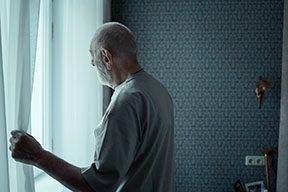This Sunday, November 1st marks the end of Daylight Savings Time for most of the country. We “fall back” and turn back the clock an hour—thus getting an extra hour of sleep time. Sounds like a wonderful windfall, right? For many older adults, the transition to shorter periods of daylight and longer periods of darkness may throw off our equilibrium for a few days. But for seniors with Alzheimer’s or dementia, the time change can exacerbate “sundowning” symptoms, including irritability, restlessness, agitation, and confusion that begins or worsens as the daylight fades.
It is not yet understood why sundowning (also known as “late day confusion”) and other sleep disturbances happen to Alzheimer’s and dementia sufferers. Some studies indicate as many as 20 percent of people with dementia will experience “increased confusion, anxiety and agitation beginning late in the day, while others may experience changes in their sleep schedule and restlessness during the night,” according to the Alzheimer’s Association.
The National Institute on Aging states that one possible cause of sundowning is that “Alzheimer’s-related brain changes can affect a person’s biological clock, leading to confused sleep-wake cycles.” During the day (when there is typically light) is when most of experience optimized brain function. An older adult may feel more tired and stressed as the day wears on. Come the evening, the senior may feel greater fatigue, as well as agitation and even depression. NIA offers these tips for family caregivers helping senior loved ones cope with sundowning.
If you care for a someone with dementia or Alzheimer’s, you may experience more difficulty in assisting that individual during this season. In addition to physical symptoms like insomnia and tremors, you may see changes in behavior such as mood swings, anxiety, ignoring directions and aggression.
Here are some ideas for reducing some of the stress that the end of Daylight Savings Time may bring (and for sundowning in general):
• Darkness can trigger agitation and confusion, so turn on lights early in the afternoon to brighten the home and try to keep rooms well-lit after dark.
• Keep to a schedule and maintain routines, but you may need to slowly adjust timing. For example, if dinnertime was at 5 while it was still light, change it to 4:30 or 4. Then over a few days, slowly adjust back to the regular dinnertime at 5. Try to have the senior you care for go to bed and wake up at the same time every day.
• When at all possible, schedule appointments and outings during the morning hours.
• Take advantage of sunny days by participating in an outdoor activity when the weather permits.
• To help promote bedtime at a consistent time, try to increase cognitive, physical and social stimulation as part of daily activities during the daytime.
• Limit or avoid caffeine, alcohol and long naps during the day, and make sure to avoid food or snacks that can disrupt sleep. Avoid large meals at dinnertime; instead, make lunch the largest meal.
• Try to distract the sundowner sufferer with any positive reinforcement, like engaging the person in a fun activity or turning on some soothing music.
Above all, stay calm and reassuring. It takes time for any of us to adjust to a time change. But if you find yourself or a senior loved one struggling with a persistent issue related to the end of Daylight Savings Time, reach out to your medical professional to seek advice. A consultation with your family physician or a medical exam may reveal another cause to the issue, such as a medication side effect.
“Senior Tips for Adjusting to the End of Daylight Savings Time,” written by Michelle Flores, Amada Blog contributor. Photo by Harli Marten @Unsplash.















